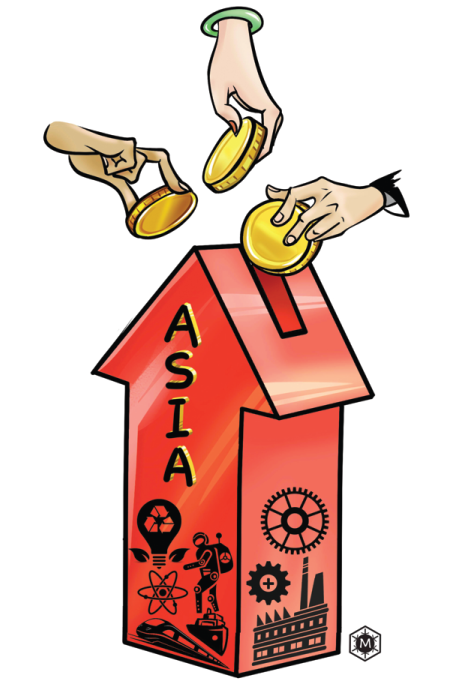Putting Asia's savings to work in region
 |
| MA XUEJING/CHINA DAILY |
As Asia has developed, it has been exporting its savings, through a trade surplus with the United States, and re-importing them, in the form of direct and portfolio investment via New York and London-a process that has created severe, though largely overlooked, financial tensions.
At the end of 2015, the combined net asset position of the Chinese mainland, Hong Kong and Taiwan, as well as Japan, the Republic of Korea and Singapore, amounted to $7.3 trillion-almost equivalent to the net international investment liability of the US. This imbalance is not likely to go away any time soon. In fact, the United States' net liabilities have grown lately-to $7.8 trillion at the end of September 2016-owing largely to its continuing current-account deficit and stronger exchange-rate effects.
So, why don't Asian countries invest their savings within their own region? An obvious reason is that the US dominates global finance, particularly in the capital and currency markets, and has also become the world's venture capitalist, investing internationally, especially in Asia, instead of just borrowing and lending.
But that doesn't mean Asian countries are better off investing in the West-not least because of the carry trade that took root after the 2008 global financial crisis. Besides, low interest rates in developed economies and a weak US dollar drove financial markets, led by the New York and London hubs, to borrow money in low-interest-rate currencies and invest in higher-interest-rate currencies.
This financial game has had a far-reaching impact. While the conventional view is that trade imbalances drive exchange rates and capital flows, financial accounting in Japan, for example, tells a different story.
From 2010 to 2015, the cumulative external surplus accounted for just 44 percent of the net change in Japan's investment position. Japan's persistent current-account surpluses should have strengthened its net international asset positions. But, thanks to the appreciation of foreign holdings of Japanese equities, the country's net international asset position actually deteriorated, from a peak of $3.8 trillion at the end of 2012 to $2.8 trillion at the end of 2015. As Bank of Japan economists point out, Japanese holdings of foreign assets are less profitable than foreign holdings of Japanese assets.
What Japan should be doing is investing more in high-growth Asia. At the end of 2015, only 10.1 percent of 574.8 trillion yen ($4.8 trillion) in gross outward investment remained in Asia, with 70 percent going to North America, Europe and Oceania.
This preference for investing outside Asia is shared by the region's other major savers, even though returns within Asia are generally higher than elsewhere. As a result, the region has been held hostage to volatility in capital flows, exchange rates and interest rates.
The problem is that, two decades after the Asian financial crisis, there has been little progress in institutionalizing Asian financial intermediaries that will channel savings to high-return projects within the region.
Now that US and European banks-driven by capital and regulatory constraints, as well as the prospects of higher US interest rates and a strengthening dollar-are beginning to move away from Asia, the pressure to remedy the situation is stronger than ever. But, instead of supporting Asian financial institutions' capacity to take over the intermediation of the region's savings, Asian financial regulators are focused on adopting the new global financial regulatory standards being pushed by their US and European counterparts-standards that the US and European politicians are threatening to unwind.
The imperative to change this approach is magnified by US President Donald Trump's "America First" credo, which is almost certain to translate into protectionist policies. Such policies will push Asian investment further into the dollar trap, because Asian savings will be used to chase speculative dollar-denominated assets outside the region, instead of meeting Asia's own needs.
To be sure, in the longer term, China's Belt and Road Initiative (the Silk Road Economic Belt and 21st Century Maritime Silk Road), together with the internationalization of the renminbi, will help to weaken the dollar's grip on Asia. But that remains a distant prospect.
In the meantime, the central banks of leading Asian surplus economies (particularly China and Japan) need to work with other major central banks (especially the European Central Bank and the Bank of England) to change how excess savings in high-growth regions are used. The goal should be to ensure that savings in surplus countries-including, say, Germany, which has a larger current-account surplus than China and Japan-are used wisely, to help sustain growth throughout the world economy.
Trump's plan to put America first may sound straightforward. But it fails to recognize that, if the emerging economies falter, everyone will lose. With Trump seemingly unwilling to rethink his approach, it is up to Asia and its international partners to gird themselves-and the entire global economy.
Andrew Sheng is a distinguished fellow of the Asia Global Institute at the University of Hong Kong and a member of the UNEP Advisory Council on Sustainable Finance. And Xiao Geng, president of the Hong Kong Institution for International Finance, is a professor at the University of Hong Kong.
Project Syndicate





















